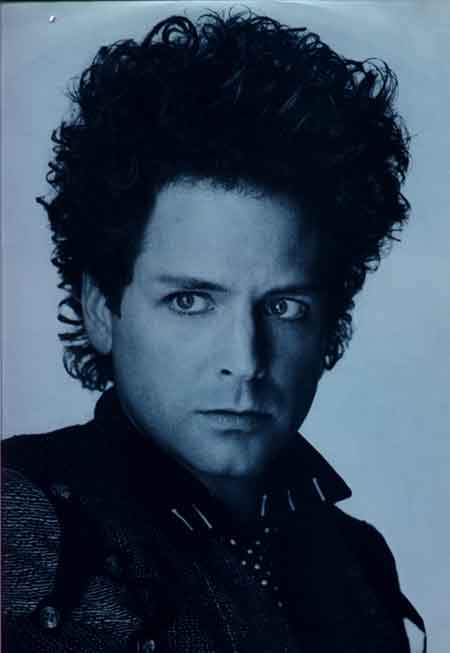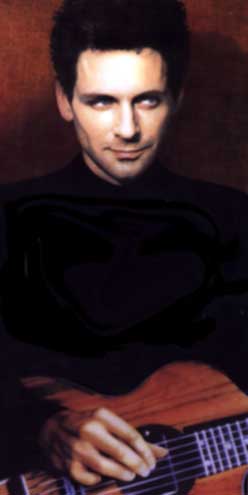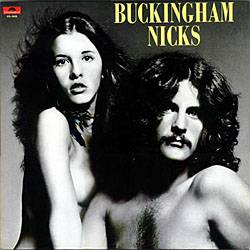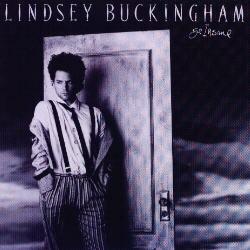|
Rumours
DVD Transcript
Originally
posted on The Ledge message boards
SECOND HAND
NEWS
Lindsey: I think we had a working title of ‘Strummer.’ I think because
it did start off as a kind of a strummy, acoustic feel. But I think the
intent for that song was to be kind of a dance beat. I know Richard Dashut
and I had been driving around from town to town during those days and had
heard Jive Talking by the Bee Gees. And we really liked the feel of that,
and they had a rolling kind of thing behind it. That was always my
intention for the feel that it should have. And I think eventually we got
there. We did accomplish that. Mick’s first inclination of the drum feel
was to go more folky. He had kind of a press role, a loose pattern, an
Irish approach, which was a more literal approach of what the song really
was and what it was giving off in its initial stages. It had quite a few
interesting textures on it. A lot of people remarked on the snare sound,
which was kind of ringy and thin. It wasn’t exactly what was considered
state of the art and it was kind of retro...and that was cool. We also had
a percussive roll that was from the seat of a nawgahide chair that was
sitting around in the studio.
Mick: You definitely found yourself doing things that were off the wall.
Some things worked, some didn’t.
Lindsey: Found sounds have always been something that interested me.
Mick: We did well with our furniture! (laughs)
DREAMS
Stevie: I think what happens with something like Dreams, the idea of
writing it in Sly Stone’s studio, black velvet bed, and curtains you
could pull...it just flowed out. It was written in about 5 minutes…and I
recorded it on a little cassette that way I wouldn’t be nervous about
playing it for the band. Everybody really liked it and we recorded it
right away.
Ken Caillat: When you guys were working on those bass and drum parts…do
you remember this coming together quickly?
John: Most of the bass parts were pretty much as they first came out of
the shoe. There might’ve been one or two exceptions…I think I butted
heads with Lindsey on one of them (laughs)…but most of them were pretty
much as they came out.
Mick: That comes from years of playing the way we played…certainly a
blues background, where you listen intently to what the vocal is doing.
John: Make it simple as possible…give it a lot of air and space. It
allows the rest of the song to have sort of an ethereal quality.
Stevie: In the beginning there wasn’t a piano, and I wrote all my songs
on guitar. I took lessons when I was 16, when I took lessons, just a few
lessons…that’s all I wrote on then. On the piano I can noozle myself
into chords, even though I don’t have any idea what I’m doing. But
still, they aren’t just C, F and G.
Lindsey: Dreams was an interesting outcome for something which didn’t
have a lot of variety in terms of it’s chord structures, but tons of
variety in terms of it’s melodic left and right turns. There were 3
distinct sections that really were the key. There is no drama without
contrast, and we made the contrast out of all that,, and it was a lot of
fun.
Stevie: That was one of the few songs that I just played and everyone went
“Oh yeah!” and liked it. You know…Dreams was a gift.
NEVER GOING BACK AGAIN
Lindsey: I remember writing that when we got off the road. It was written
about a girl that I had met in New England and spent a very short amount
of time with. Someone who really, initially, didn’t want to spend time
with me, and I talked her into it. And of course, “been down one time,
been down two times, never going back again” is really a sweet
sentiment. It’s a naïve sentiment. Because every time you are happy,
you create this illusion for yourself that you’re never gonna be unhappy
again. Life doesn’t really work that way, and you have to learn to
accept that you’ll have ups and downs your entire life. So that was
really the sentiment of the song for me.
We weren’t clear initially how clear on how we wanted to approach it. I
think Mick had put some brushes on it and therefore we had the working
title of Brushes. Eventually it got paired down to just two guitars, a
left and right guitar. It did go through it’s own evolution of trying
other things. I think the initial attempt was going to be a more
orchestral approach, a more layered approach. But I think eventually we
came back to a simple approach with was suited to the sentiment of the
song.
DON’T STOP
Christine: I think I wrote that in the condos that Stevie and I shared.
Stevie: It was fabulous. Chris and I did move into two little apartments
right next door to each other. And we had a ball. It was really neat.
Lindsey: Don’t Stop was really Christine’s song. It’s in the
tradition of her roots…and John and Mick’s 12 bar blues roots and
shuffles.
John: The ole’ shuffle was right up Mick and mine’s alley.
Mick: That’s why we get paid the big bucks! (laughter)
Christine: I’ve written a few shuffles before. This one being my most
famous. I think I was very happy when I wrote it.
Lindsey: The fact that we shared verses, and mine was first, it kind of
muddied the lines of whose song it was. But it really was kind of a great
collaboration in the sense that some of hers and mine musical senses
overlap… and I think it worked very well to the advantage of that song.
GO YOUR OWN WAY
Lindsey: It may have been the first song that I played as an offering to
the band. It was in Miami, and I played it for them, and it met with such
a strong response. It really broke the ice and set the tone for the album
in general. It got everyone off on the right foot, and let everyone feel
that we had a strong place to go.
Mick: Lindsey has this very specific idea for the drum parts he wanted.
But one thing he didn’t realize was that I couldn’t play them. And it
blew his mind! (laughs) He said you have to be able to play that! He had
liked some of the parts on the early Fleetwood Mac records.
Lindsey: After we got to Sausalito to begin recording, I was listening to
a Stones song called Street Fighting which had a drum beat similar to what
Mick played. It wasn’t the kind of thing Mick did, and he did his own
version.
Mick: I did as good a job as I could do to get Lindsey’s beat...and then
completely screwed it up! (laughter)
Lindsey: The solo at the end was certainly a template for things that
happened after that. I really think Ken Caillat did a great job of getting
the sound that solo needed. It defined an approach for years to come.
Mick: I can certainly say that the solo, without fail, to this day I get
goosebumps. Especially in the car. I turn it up and go ‘YES’! It’s
so cool. It’s one of the most classic guitar solos ever. It’s one more
ounce of juice as you get out of the car. Brilliant.
SILVER SPRINGS
Stevie: I got the idea from a freeway sign as we drove under the sign that
said Silver Springs, Maryland. And…that’s the kind of writer that I
am. If I hear a name I really like, I can maybe write a story about it.
Lindsey: It’s an interesting song in what it seems to be saying. Very
bittersweet…because she’s talking about being MY Silver Spring, and
what we could have been as lovers. A beautifully put together song on a
musical level. It has some of the best guitar work on the album, speaking
for what I was able to contribute to it. A lot of layering and volume
pedals, textures across the top, and acoustic picking.
Mick: The subtlety of what we got into as players…you really hear a lot
of these delicate things that went on during the recording. Most of it was
amazingly natural.
Lindsey: I know Stevie was disappointed that it didn’t make it at the
time. We were worried a bit about the flow of the album and what the album
needed. It was a shame that it didn’t make it. It was certainly
warranted.
Mick: The reason why it didn’t make it was because vinyl was good
quality up to 22 minutes per side. So we had to cut a song unfortunately.
Christine: It’s back where it belongs. It should’ve been on the
record, and we all loved it. I get the chills actually, listening to it.
Lindsey: It’s like a great scene from a movie that gets cut and left on
the cutting room floor. But it is…it’s a great song.
Stevie: It’s like…the couple is back together!
Mick: At last I can rest easy. I was the unfortunate person who had to
tell Stevie it wasn’t going on the album. Well now you can forgive me
Stevie.
THE CHAIN
Lindsey: I think it was a really an interesting collaboration of forces.
It started off as a song of Christine’s called ‘Keep Me There’ and
much of that did not end up being the song. We had the tag ending to the
song.
Mick: Lindsey ran with whatever Chris had formulated and then basically
ended up hitting a brick wall. And it felt like the whole thing was just
never gonna work. They all got this revelation, and suddenly it just made
sense, like a jigsaw puzzle.
Lindsey: I came in one day, and said why don’t we just remove the
verses? And we can do some sort of measurement of what the tape is, and do
a reverse count back from there to create a metronome to play to, and once
we have the blank tape in we can figure out what we want to put in there!
Mick or I laid down the kick drum that gave us a start point. Eventually I
started fooling with the dobro and that became the foundation for what was
written over that. The 3 part harmony of listen to the wind blow was a
collaboration of the three writers.
Christine: I remember Stevie, Lindsey and myself sitting in my den and
doing the 3 parts. Lindsey with his guitar and trying to figure out the
chords things to go underneath the vocals.
Stevie: I had written another song. The whole ‘running in the shadows’
thing. And Lindsey said can we use this? So of course I said yes…so it
was funny that I had that melody and those words or it never would’ve
happened.
Mick: Lindsey is more prone to see different pieces of things. Not only in
his own songwriting, but in the girls’ songwriting and picking parts
out.
Lindsey: We were able to think of tape as a very plastic, cinematic and
abstract way. Just to come up with pieces of music we could treat as
pieces of film, and we came up with something that was truly a communal
effort.
Stevie: I remember that great solo of John’s (hums the bass solo)…and
it was like the monsters are coming! And we all loved that.
John: That was an Olympic fretless bass on a stainless fretboard with a
pick. And I was just messin about in the studio and I just played the
riff. Chris said ‘Oh! I like that!’ So we kept it in. If I had my way,
I would’ve brought the band in a little earlier on the ending…it tends
to stand out and look a little lonely out there, but it seems to work.
Mick: You can’t change it now John, you’d break too many people’s
hearts! (laughs)
Christine: I guess we must’ve just loved that bass part so much to do
something with it. And Lindsey raved and put that guitar solo on it.
Mick: It’s one of the best examples of how things can work from a
different point of view. The collaboration of the band brought it back to
the shape it’s now in. It’s one of those songs that could’ve ended
up in the dust bin, and it didn’t.
YOU MAKE LOVING FUN
Lindsey: You Make Loving Fun might be my favorite song of Christine’s.
It seems to cover so much ground on so many levels. She’s got this
clavinet part which is very “her”, but the approaches were a little
bit different from what we did on other songs.
Christine: I felt it needed something dark underneath it. And it was…it
was a clavinet with a wah-wah pedal. And Mick was on the floor doing it
manually.
Lindsey: I thought on a production level that song turned out really well
and just in terms of reeling out Christine’s normal tendencies. The feel
of it is just so great. It’s got a real nice R&B feel to it. It
actually took a turn for the ethereal and sweet that you wouldn’t expect
from where it was going in the beginning. I remember being up at Wally
Heider’s and just trying to make that “never did believe” section go
somewhere else and then make it snap back into place.
Christine: I’ve got the luxury of building this on my own. I built up
this rocking riff with the bass and drums. The whole thing was all
keyboards.
Mick: All keyboard players seem to be detached sometimes. And Chris has
always been in that thing right there with me and John.
Christine: I had learned playing with Mick and John. I’ve never
considered myself a lead keyboard player…but part of the rhythm section.
Lindsey: That album is just rife with great tags. And that song was one of
the best. Where you have a little bit at the end, where it is a little
masterpiece unto itself.
I DON’T WANT TO KNOW
Lindsey: It was actually something Stevie and I were doing before we were
in the band.
Stevie: It was on the demo we came to LA with.
Lindsey: That would’ve been back in 1974 when she wrote that. And we did
perform that live on several occasions. I think it was slightly inspired
by Buddy Holly, after the Buckingham Nicks era certainly. But when we
tried to get things going, and we were dealing with indifference from
management and label and people trying to get us on the circuit.
Mick: That song often gets forgotten about in terms of it being part of
Rumours. I think it’s really unique. You get those voices together. And
that was their style. That’s says what it was that we heard that they
brought into this thing called Fleetwood Mac. Everything else grew from
around that and all the exchanges with Chris and Lindsey and Stevie as
writers and me and John playing. It became a unique thing.
Lindsey: We had to make a call on what the album needed. Kind of the group
will would edit in and out what was working and what wasn’t. And that
was great. At the eleventh hour to cut in something and have it be so
straight ahead, and it didn’t require any pondering at all. That’s the
atypical song on Rumours for sure.
OH DADDY
Mick: Great bass parts Johnny.
John: That just came out. I couldn’t think of anything else to do. I
still think it’s too busy behind her voice. It works I guess.
Christine: Who was daddy? Well it was loosely based on Mick’s life.
Mick: Genius Chris! (laughs)
Christine: Mick’s the big daddy for sure. And we always call him big
daddy. I was being a little sarcastic on the chorus. You know, how can you
think you’re always so right? And I could never get the last line.
Stevie gave me last line “and I can’t walk away from you if I tried”
and I just knew I was going to say it.
Stevie: That is my very favorite Chris song. And it always, always was. I
really came from a folk-singer guitar and song thing. With Chris, being an
accomplished pianist, she came from a different place. So it’s like we
all have our strengths.
Lindsey: It’s funny how certain little things that happen by accident in
any creative process and get left in, because somehow they are happy
accidents. You kind of have to be on the lookout for those things.
Sometimes something very small can create an ambiance and magic and
something that would be less if it didn’t exist. There is a keyboard
blip on the end, which was not something she was playing interpretively.
You know…it wasn’t jazz! It was just her saying, hey what are you
doing in there? And it got left in there…just one of things you wait
for.
Christine: We just decided to leave it in.
GOLD DUST WOMAN
Stevie: Well I’m sure the gold dust woman was me. It was kind of written
about LA and how heavy it was here. The whole Los Angeles and ‘Hollywood
thing’ you know.
Lindsey: It’s probably the loosest thing on the whole record, in the
best possible way. It’s kind of jazzy and moves into an area of
non-structure. I think that’s where everything was going. It was really
a no-holds-barred approach that started off in a structured place, and
there were 3 part harmonies that were relative to everything else on the
album.
Mick: It was a candidate to unleash a cacophony of sounds and things that
you could hear…trailing off over the mountains.
Stevie: Didn’t we do something very scary like throwing down glass? I
think we took it off in the end because it was too scary…and we did it
again on Tusk I think.
Lindsey: It’s a great piece. The whole tag of that song…Mick was doing
some transcended keyboard parts and it was really an evolving song.
Mick: Transcension was a word made back in the 70s. Truly from fatigue or
various abuses, one found yourself doing things that were off the wall.
Some worked and some didn’t. It was truly an example of that because
Stevie thought she was a cat! (Stevie purrs)
SONGBIRD
Christine: I definitely wrote that in my room in half an hour. I remember
coming in and all the guys were in the control room. They were completely
oblivious to the fact that I was shaking in my boots cause I’d written
this song and I didn’t know where it came from. And I was playing it and
all of sudden the whole studio went quiet and everyone diverted there
attention to me and when the song stopped I remember everyone saying that
was bloody fantastic. Thank God you put it on a two track.
Lindsey: To place it right after Go Your Own Way was just so great. I
actually remember when the album was done…and one of the local radio
stations had played the whole album and took a break between sides. And
Richard Dashut and I were in our car when we still lived on Putney, and
listened to this. I can remember when Go Your Own Way came in and we were
so aggressive at the end and it was a great thing. That song came off ,
and then Songbird came on. And the masculinity and aggressiveness that was
the end of Go Your Own Way transformed into that intimate female,
introspective side of Songbird which followed. I honestly remember that
the DJ that addressed the listeners before playing Side Two, you could
tell she’d been crying! And that was the combination of Go Your Own Way
into Songbird.
Mick: Songbird is always Chris alone with the audience. And we always saw
it like that. And it survives like that to this day. It hits
people…it’s amazing. It’s like a little prayer, or a Fleetwood Mac
prayer. It has a tremendous power.
Christine: It wasn’t about anyone in particular at all. It was for
everybody.
back
to Lindsey in-print
|






